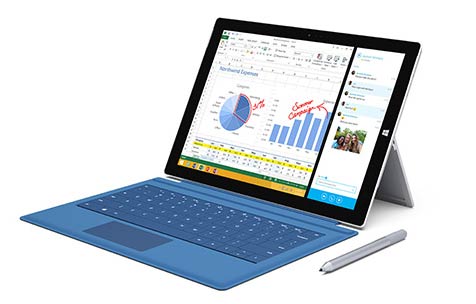It is fascinating to watch Microsoft (and other vendors) try to come up with a next-generation tablet. The most successful tablet was the iPad and the only tablet that really challenged it was the Samsung Galaxy tablet, which was about as close to a knockoff of the iPad as you are likely to get. Amazon did a credible job, largely because it approached the market very differently, using a reader as the anchor (Steve Jobs didn’t believe people actually read anymore), and in a size class (7-8”) that Jobs didn’t believe in.
The iPad created the BYOD (bring your own device) wave and rolled into companies over the initial objections of IT, ironically the same way Windows 95 did, and broke Microsoft’s hold on the desktop. But it wasn’t a business-focused device. It lacked security, and the Android copies drifted even farther from the ideal. But the Windows tablets, often two-in-one designs favoring a more traditional laptop form factor, didn’t resonate and appeared to repeat the same mistake that Microsoft’s earlier efforts made: If the device looks like a laptop, that’s how it will be used and the cost premium will kill it.
Surface Pro 3 looks to have a better approach to the problem, largely by not looking like a laptop and stepping farther away from the iPad norm. But it is also a step in the evolution of this class, suggesting an even more interesting end game. Let me explain.
iPad Problem
The iPad creates two problems for the user and IT. It was designed primarily as a consumption device but not to be a reader, which would be the most likely form of material consumed in business. Yes, we do get training videos and folks occasionally do video conferencing, but neither typically requires a hand-held device. Tablets have historically been for documentation and forms when used in business, which is why the slate form factor sustained while the various twist-screen two-in-one variants haven’t.
Users initially did try to use the iPad for creation, and there have been some amazing things done on iPads, but these tend to be in the area of performance art or extreme use, and they are not very practical as a sustaining practice. In fact, if you look around, you’ll likely see that fewer people are actually using iPads to create than two years ago.
Employees who are looking for a tablet want both the productivity of a business product and the capability of an iPad. Nothing yet does both, but the Surface Pro 3 comes far closer than ever before.
Size Matters
It turns out that size matters and the size of the iPad really suffers on forms and for reading documents formatted for business. It is simply too small. Ironically, for reading novels, it is also too large, showcasing that reading wasn’t a design consideration. The larger Surface Pro 3 screen is far better for reading documents and its Intel processor makes it far more useful, when combined with that screen, running legacy applications and stepping in as a laptop replacement.
You see, that was the other problem. As light as an iPad is, when coupled with a regular notebook, the combined weight of both devices and chargers shifted and became too heavy. Users clearly wanted one device that could fill both roles.
Surface Pro 3 is much more similar to professional tablets, like those made by Fujitsu (once dominant for forms), yet approaches the iPad weight and battery life. (Over the last several years, many of the popular iPad apps have made it to Windows as well, though the platform still lags iOS.)
In the end, what makes Surface Pro 3 better is that it isn’t trying as hard to be a two-in-one; it is focused on being a great tablet that can pinch hit for a notebook, which is a lot closer to what folks considering a tablet for business wanted. Microsoft’s improved marketing of the product has been gradually turning heads in the right direction as well, and often this is as much about changing perceptions as it is anything else.
Wrapping Up: Looking Forward on Tablets
A lot of interesting technologies will be coming to market that will change tablet use dramatically. This week, Amazon is expected to announce a 3D phone and you have to know 3D will jump to tablets shortly thereafter. Security has to be improved, with massive advancements in viruses and militarized malware making broad inroads into businesses. Microsoft’s Cortana, which is a huge step forward in personal assistants, hits the market this month. And a number of advances in battery life and wireless charging should make the tablets of tomorrow very different from the tablets of today.
The core lesson here is that a great product has to know what it wants to be. Two-in-one products tried to be two things but they weren’t optimal in either role, which is why they have undersold expectations. The Surface Pro 3 approach, focusing on being really great at something first, or more of a tablet+ design, should play better until such time that people truly are shopping for two-in-ones.
Expect big changes here in the coming years. Tablets in general are far from where they need to be and the race is on to create the next iPad event in technology.



